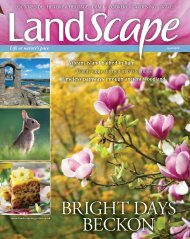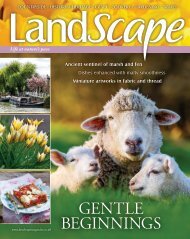Garden News
You also want an ePaper? Increase the reach of your titles
YUMPU automatically turns print PDFs into web optimized ePapers that Google loves.
Carol Klein 'My favourite<br />
plants for winter scent'<br />
January 27, 2018 ONLY £1.99!<br />
FREE<br />
SEEDS<br />
£2.29<br />
worth<br />
Britain's<br />
most trusted<br />
voice in<br />
gardening<br />
FREE<br />
SEEDS<br />
£2.29<br />
worth<br />
Plant a mixed<br />
hedge for nuts<br />
and berries<br />
brand new<br />
dahlias to<br />
grow in 2018!<br />
Try hyacinths to<br />
kick-start your spring<br />
THIS WEEK'S JOBS<br />
✔ Plant up a potted<br />
bulb display<br />
✔ Prune hydrangeas<br />
✔ Take blackcurrant<br />
cuttings 5<br />
Plan for<br />
a year of<br />
success!<br />
The eight plants you<br />
can always rely on<br />
PLUS Grow the surprise<br />
plants you can eat!<br />
sedges and rushes<br />
for interest all year
WHAT TO DO<br />
Meet<br />
the<br />
team<br />
If you do<br />
Ian Hodgson<br />
Kew-trained horticulturist and<br />
garden designer. Previously<br />
with the RHS, Ian is interested<br />
in all aspects of gardening.<br />
just one job...<br />
Repair<br />
wooden<br />
structures<br />
Take the time to do it now<br />
while it’s quiet in the garden<br />
Karen Murphy<br />
A keen all-round<br />
gardener, Karen has<br />
RHS qualifications<br />
and also loves wildlife.<br />
THIS<br />
WEEK!<br />
Martin Fish<br />
Former head<br />
gardener, TV and<br />
radio broadcaster<br />
and RHS judge.<br />
Many features and structures in the garden, such as<br />
fences, trellis, pergolas, sheds and summer houses,<br />
are made from wood, and to keep them in good<br />
condition they need a little attention occasionally.<br />
The majority tend to be made from pressure-treated<br />
timber, where the preservative has been forced under<br />
pressure into the centre of the timber, and is often referred to<br />
as tanalised. If you’re buying new fencing or other wooden<br />
features, always go for treated timber, which will last for<br />
many years, as untreated wood will soon rot in damp<br />
conditions. In theory, pressure-treated timber doesn’t need<br />
any additional preservatives painting on, but you can stain or<br />
paint the structures in a colour of your choice and this is a<br />
good job to do in winter, as long as what you’re treating is dry.<br />
Winter winds can also cause damage to structures and<br />
these need fixing as soon as possible. While it’s quiet in the<br />
garden check sheds and other wooden structures and carry<br />
out repairs. This might be as simple as nailing or screwing a<br />
loose board, to replacing rotten or damaged wood with new.<br />
Top<br />
Tips<br />
Make sure any wooden<br />
uprights are sturdy after<br />
winter weather strikes<br />
Photos: Martin Fish, unless stated<br />
1Check trellis panels<br />
supporting climbers and if<br />
some of them are loose, fix with<br />
small nails.<br />
Fences also need checking<br />
2 over and any loose panels or<br />
boards should be nailed or<br />
screwed tight.<br />
Check fence posts and the<br />
3 supports of arches and<br />
pergolas to make sure they’re<br />
not rotting at soil level.<br />
In dry weather freshen up<br />
4 painted or treated structures<br />
with a fresh coat, after sanding<br />
any rough edges first.<br />
Subscribe and get 4 issues for just £1! Go to www.greatmagazines.co.uk/gn<br />
January 27 2018 / <strong>Garden</strong> <strong>News</strong> 29
P.40<br />
The best new<br />
dahlias for 2018<br />
Reasons to<br />
be cheerful<br />
Last week saw ‘Blue Monday’,<br />
when apparently people are more<br />
depressed than on any other day<br />
of the year. A combination of bad<br />
weather, short days and post-<br />
Christmas malaise takes it toll, it<br />
would appear – so on our Facebook<br />
and Twitter pages we decided to<br />
cheer up our followers with glorious<br />
summer garden pictures, and<br />
asked them to share their own.<br />
The results were wonderful, with<br />
lots of readers posting their own<br />
pictures that certainly made us<br />
smile here at <strong>Garden</strong> <strong>News</strong>!<br />
So ‘Blue Monday’ was well and<br />
truly put behind us and<br />
now we’re looking ahead<br />
to the colour of spring – it<br />
will be here soon! Have a<br />
great gardening week.<br />
<strong>Garden</strong> <strong>News</strong><br />
Editor<br />
Britain’s most trusted<br />
voice in gardening<br />
P.35<br />
Add scent<br />
and stature to<br />
your garden<br />
P.36<br />
Take<br />
blackcurrant<br />
cuttings now<br />
P.18<br />
<strong>Garden</strong> of<br />
the Week<br />
Our cover star:<br />
Edgeworthia<br />
chrysantha rubra<br />
The paperbush plant is a star of the winter<br />
garden, bringing interest when little else<br />
is in flower. Closely related to daphne, it<br />
also produces an intense fragrance).<br />
Marianne Maierus<br />
Naomi Slade<br />
Martin Fish<br />
GAP<br />
Subscribe today<br />
& GET 4 ISSUES FOR<br />
JUST £4<br />
Go to p.28 for full details!<br />
Look inside!<br />
About Now<br />
4 <strong>News</strong> from the gardening world<br />
5 Plant of the Week: Hyacinths<br />
6 Top 5... Ornamental<br />
sedges and rushes<br />
7 My Life in Plants<br />
9 Very Important Plant<br />
10 Wildlife<br />
Features<br />
12 Create a fail-safe garden<br />
16 What’s legally right and wrong<br />
in the garden?<br />
18 <strong>Garden</strong> of the Week<br />
22 Grow unusual edibles<br />
26 Carol Klein on her favourite<br />
plants for winter scent<br />
58 Homegrown: Celeriac<br />
What To Do This Week<br />
29 Repair wooden structures<br />
30 Plant up a potted bulb display<br />
33 Nick Bailey’s simple guide to<br />
putting wire supports on a wall<br />
35 Naomi Watts beats the January<br />
blues with scent and stature<br />
36 Take blackcurrant cuttings<br />
37 Medwyn Williams is preparing<br />
his beds for planting<br />
39 Terry Walton gets a potato<br />
surprise on his plot!<br />
The Experts<br />
40 Dave Gillam reveals his pick of<br />
the best dahlias for 2018<br />
41 Take cuttings of chrysanths<br />
43 Tony Dickerson answers your<br />
questions<br />
You and Your <strong>Garden</strong>s<br />
46 Readers’ gardens<br />
49 Your letters and photos<br />
Offers & Competitions<br />
51 Prize-winning crossword<br />
52 Save 25 per cent on begonias<br />
53 Buy a native woodland collection<br />
55 Agapanthus and iris Louisiana<br />
for every reader<br />
Get in touch!<br />
P.5<br />
Email gn.letters@bauermedia.co.uk<br />
Facebook facebook.com/<br />
<strong>Garden</strong><strong>News</strong>Official<br />
Twitter twitter.com/<strong>Garden</strong><strong>News</strong>Mag<br />
Write to Simon Caney, <strong>Garden</strong> <strong>News</strong>,<br />
Media House, Peterborough Business<br />
Park, Lynch Wood, Peterborough PE2 6EA<br />
January 27 2018 / <strong>Garden</strong> <strong>News</strong>
Letter of the la<br />
Sometimes it’s unclear what’s legally wrong and right when it comes<br />
to garden rules. Here are seven of the more common regulations<br />
Words: Karen Murphy<br />
OVERGROWN HEDGES<br />
1It goes without saying that you’re<br />
responsible for looking after your own<br />
hedges, and making sure they’re not a<br />
nuisance to anyone else. Always do some<br />
research on what hedges are the best for<br />
your plot before you go and make a planting<br />
error! Chat to your neighbour reasonably<br />
if the hedge on their land is too high, and<br />
offer some gardening help if they need it.<br />
If the hedge is stopping you enjoying your<br />
garden, blocks your view or blocks out light<br />
getting to your house or garden, you can<br />
contact your local council, but only if your<br />
neighbour isn’t taking your concerns into<br />
account. A mostly evergreen hedge over 2m<br />
(6½ft) tall constitutes a ‘high hedge’, and<br />
can be considered in complaints.<br />
Make sure your<br />
planting won’t affect<br />
neighbouring properties<br />
Shutterstock<br />
Alamy<br />
A home bonfire<br />
isn’t illegal but<br />
can be a nuisance<br />
GARDEN BONFIRES<br />
2Contrary to popular opinion,<br />
it’s not illegal to have a<br />
garden bonfire, but if your<br />
bonfire becomes a nuisance to<br />
others, that’s where the problems<br />
start. If your bonfire emits lots<br />
of smoke, fumes or gasses that<br />
endanger passersby or traffic,<br />
you may be fined. Wait for a clear<br />
day with no wind to reduce any<br />
neighbourly disputes! Keep most<br />
of your garden green waste for the<br />
compost heap, but thick prunings,<br />
logs and nuisance weeds are good<br />
bonfire staples. Never burn plastic,<br />
rubber or anything non-plant<br />
related. And be aware of your<br />
garden wildlife, too!<br />
CHICKEN KEEPING<br />
3Chicken keeping is quite<br />
straightforward, but you must<br />
consider their health and<br />
welfare at all times, and provide a<br />
reasonably-sized dwelling for them.<br />
Make sure your chickens aren’t a<br />
nuisance to neighbours, for example,<br />
roaming freely and eating their<br />
plants! Check that you’re allowed to<br />
keep chickens too, as some house<br />
deeds or council legislation states<br />
you may not be allowed to. If you<br />
intend to keep more than 50, you<br />
must register them with DEFRA<br />
– fewer than that and you aren’t<br />
restricted and can happily sell or<br />
give away healthy eggs.<br />
Your chickens’ welfare<br />
is the main priority<br />
Alamy<br />
Always check that any<br />
garden buildings don’t<br />
need planning permission<br />
PLANNING PERMISSION<br />
4When it comes to building<br />
greenhouses and sheds there are<br />
not usually any restrictions, but<br />
there are a few pointers to note in some<br />
cases. Will it obstruct views, be over 4m<br />
(13ft) high, built in a front garden or be<br />
built in a conservation area? If so, consult<br />
your council. A garden wall that’s more<br />
than 2m (6½ft) high may have to be<br />
registered with planning permission, too.<br />
16 <strong>Garden</strong> <strong>News</strong> / January 27 2018
w...<br />
Are your garden<br />
chemicals still in<br />
date or legal to use?<br />
Alamy<br />
DISPOSING OF<br />
GARDEN CHEMICALS<br />
5Always check your chemicals<br />
are in date and properly<br />
labelled, and be aware that<br />
some of your older ones may have<br />
been discontinued. Visit www.rhs.<br />
org.uk and search for ‘withdrawn<br />
chemicals’ for more information.<br />
Permitted chemical containers<br />
must have their contents finished<br />
up on a designated plant and rinsed<br />
out carefully before being put in the<br />
household recycling. Contact your<br />
council waste disposal department<br />
to ask where you can get rid of<br />
withdrawn chemicals in your area.<br />
Alamy<br />
Try offering to help if<br />
your neighbour lets their<br />
garden become unruly<br />
Trees can throw<br />
up a number of<br />
legal issues!<br />
Alamy<br />
NEIGHBOUR NEGLECT<br />
6It’s disheartening when a neighbour neglects<br />
their garden, particularly when you put so much<br />
effort into your own! A friendly chat with them<br />
always goes down well, and you can bring up your<br />
concerns about encroaching weeds, for example. Plus<br />
your gardening knowledge may be very welcome. If<br />
they don’t comply with your neighbourly help, you can<br />
contact your local authority if they’re spreading certain<br />
weeds, such as creeping thistle and ragwort. Also if<br />
they’re endangering anyone or obstructing rights of way<br />
you can get the authorities involved.<br />
Shutterstock<br />
THE TRUTH ON TREES<br />
7It’s tricky when it comes to trees – keeping them in check<br />
can become a real job. There are a few important things<br />
to remember if a tree becomes a nuisance. You can trim<br />
overhanging branches from a neighbour’s tree, but only up<br />
to the boundary line, and then you have to offer the trimmed<br />
branches back to them. The same goes for overhanging fruit<br />
or windfalls – always give them back to the tree owner, even if<br />
they fall in your garden! Don’t just throw anything back over<br />
the fence either as this is considered antisocial. Any tree on the<br />
boundary line belongs to both parties and neighbours aren’t<br />
obliged to clear their tree’s leaves unless a drain is blocked.<br />
And finally, nests and roosts in any tree are protected by law.<br />
Subscribe and get 4 issues for just £1! Go to www.greatmagazines.co.uk/gn<br />
January 27 2018 / <strong>Garden</strong> <strong>News</strong> 17
Grow<br />
unusual<br />
edibles!<br />
Enjoy tasty treats from<br />
unconventional sources<br />
Words Karen Murphy<br />
Be it border shrubs and bedding blooms, or more<br />
recognisable fruiting bushes, there are lots of tasty<br />
treats you can grow this year. Fear not if you<br />
haven’t got a fruit patch, simply pack your beds with<br />
edible plants! We’ve also chosen a few old fruiting<br />
favourites, revamped for new taste, colour and form.<br />
Alamy<br />
New ways with old favourites:<br />
Try these unusual selections<br />
Raspberry ‘Autumn Amber’<br />
A perennial fruiter, this gorgeous golden raspberry is<br />
practically thornless and is high-yielding. This has been<br />
well-bred at the famous fruit research institute at East<br />
Malling in Kent to be highly resistant to disease and to fruit<br />
every year. A delicious, eye-catching, apricot-coloured<br />
treat for autumn! Plant now for this year’s fruit.<br />
Supplier: www.lubera.co.uk.<br />
Greencurrant ‘Greenlife’<br />
A delicious, sweet currant that lacks the usual red-black pigment,<br />
this is an attractive, leafy currant with unusual berries. A fabulous<br />
addition to the fruit bowl, which has the added bonus of being<br />
unattractive to the spotted wing drosophila (fruit flies) because of<br />
its colour. It has been detected in our gardens recently and prefers<br />
to attack unripe black or red fruit. Plant now potted or bare-root.<br />
Supplier: www.lubera.co.uk.<br />
22 <strong>Garden</strong> <strong>News</strong> / January 27 2018
Blueberry<br />
‘Pink Lemonade’<br />
One of the many merits of a<br />
blueberry is its striking ornamental<br />
value. This means you can quite<br />
happily grow one in an acidic spot<br />
in your garden, or as an individual<br />
specimen in an ericaceous container.<br />
This unusual ‘pinkberry’, which is just<br />
as tasty as its blue cousins, needs a<br />
sunny spot; pinkish flowers become<br />
pink berries, deepening to a darker<br />
colour. Plant now and feed in spring.<br />
Supplier: www.lubera.co.uk.<br />
Tasty flowers to try…<br />
Eat these border blooms<br />
Tulbaghia violacea<br />
A very pretty member of the allium<br />
family with pungent, garlicky leaves<br />
and flowers – some say it shouldn’t be<br />
used as a cut flower for this reason!<br />
An easy container or border plant<br />
that will pep up salads and other<br />
cooking, like chives do. Its common<br />
name is ‘society garlic’ as it’s said<br />
the aroma and taste is less socially<br />
unacceptable; perfect for society<br />
functions! It can be used a companion<br />
plant to deter pests, much like<br />
onions and garlic. Order dormant<br />
roots now for planting in May.<br />
Supplier: www.unwins.co.uk.<br />
Alamy<br />
Photos: Shutterstock, unless stated<br />
Actinidia arguta ‘Issai’<br />
A fantastic, hardy, little snacking kiwi<br />
that can be grown outside in our winters.<br />
Smooth-skinned fruit the size of plums,<br />
there’s no peeling necessary! It fruits in<br />
late summer and doesn’t need a fertilising<br />
companion. Supplied as a potted plant to<br />
get in the ground now in a sunny spot.<br />
Supplier: www.bakker.com.<br />
Lubera<br />
Aquilegia vulgaris<br />
Lovely purple, spurred bonnet blooms of<br />
this common columbine, which naturalise<br />
fantastically in part shade. Short-lived<br />
flowers in May and June but so worth it! Its<br />
flowers are edible and sweet to taste. Sown<br />
directly in March they’ll flower next year.<br />
Supplier: Seeds from www.crocus.co.uk.<br />
Viola odorata<br />
Sweet violets have a heavenly scent<br />
throughout early spring and are an<br />
excellent garnish for salads and pasta<br />
dishes, but a classic way to use them is<br />
to crystalise them in sugar and use as<br />
cake toppers. A swathe of these<br />
growing in a dappled woodland shady<br />
spot in your garden will bring<br />
sumptuous scent to your plot. Bare<br />
root plants supplied for planting now.<br />
Supplier: www.marshalls-seeds.co.uk.<br />
Hemerocallis<br />
‘Stella de Oro’<br />
Daylilies are little known<br />
excellent edibles, and some<br />
gardeners swear by their<br />
blooms, which can be added to<br />
salads and other dishes much<br />
like courgette flowers. A hardy,<br />
vigorous, late summer bloomer<br />
for a beautiful border. Order<br />
now to plant in mid-spring for<br />
blooms in July and August.<br />
Supplier: www.agroforestry.co.uk.<br />
Subscribe and get 4 issues for just £1! Go to www.greatmagazines.co.uk/gn<br />
January 27 2018 / <strong>Garden</strong> <strong>News</strong> 23
Well I never knew that!<br />
Four fruity bushes you can eat<br />
Berberis vulgaris<br />
Our very own native British barberry – an attractive, red-tinged,<br />
deciduous, thorny shrub with lots of droops of edible berries in summer<br />
and autumn. The fruits are sharp and lemony and are great to harvest<br />
from a native hedge in your back garden! Plant berberis shrubs now.<br />
Supplier: www.agroforestry.co.uk.<br />
Mahonia aquifolium<br />
Less prickly leaves than other<br />
mahonias, and with puffed blooms<br />
instead of tall spires. It flowers in<br />
spring followed by berries. Mahonias<br />
are fantastic shade lovers, which<br />
are evergreen and very versatile.<br />
Plant it under a hedge or as a<br />
colourful utility shrub and ground<br />
cover. It’s not just the berries that<br />
are edible, it’s the flowers, too.<br />
Supplier: www.agroforestry.co.uk.<br />
Cornus mas<br />
This winter-flowering cornus has its characteristic fluffs of<br />
yellow flowers, which are a great source of food for early<br />
bees, but it’s the glossy cherry fruits in summer and autumn<br />
that make it a useful edible for the garden. These fruits taste<br />
like plums. Plant now for blooms and fruits in future years.<br />
Supplier: www.burncoose.co.uk.<br />
Sorbus aucuparia edulis<br />
This is a cultivated variety of our native rowan, which has particularly<br />
edible berries and is thought to have been brought to cultivation in<br />
the 19th century. It’ll stay relatively compact for many years as most<br />
rowans do. Try the fruit in warming berry puddings or as rowan jelly.<br />
There’s still plenty of time to plant bare-root trees and bushes now.<br />
Supplier: Beechwood Nurseries – www.3fatpigs.co.uk.<br />
GAP<br />
24 <strong>Garden</strong> <strong>News</strong> / January 27 2018
WHAT TO DO THIS WEEK<br />
in your flower garden<br />
Plant up a potted<br />
bulb display<br />
Celebrate the season<br />
with a bright and<br />
cheerful creation<br />
Now’s the time of year when<br />
gardeners get a little<br />
excited about the<br />
imminent influx of spring blooms<br />
and new growth, as well as the<br />
promise of much lovelier weather<br />
to get out in! So to celebrate the<br />
season and create something<br />
pretty, why not get some<br />
colourful planting underway<br />
and jazz up your windowsills<br />
and outdoor tables with a<br />
selection of potted bulbs?<br />
Instead of individual clusters of<br />
plants, plant a few pots of bulbs<br />
together in different sizes of shallow<br />
bowls, with taller ones at the back or<br />
in the middle, surrounded by smaller<br />
irises and snowdrops, for example.<br />
You could even daintily edge your<br />
pots in low-growing winter aconites.<br />
Tuck in a few and then backfill tightly<br />
with multi-purpose compost, finishing<br />
off with your mossy topper to add a<br />
natural woodland feel to your display.<br />
Nothing says ‘bring on spring’ more<br />
than lots of early-flowering bulbs to<br />
admire! Once they’ve all finished<br />
flowering, leave their leaves for a few<br />
weeks, then trim them right down.<br />
You can plant them out in the garden<br />
once they’ve gone over.<br />
<strong>Garden</strong> <strong>News</strong><br />
RECOMMENDS<br />
It’s easy to make an<br />
indoor bulb display<br />
to brighten a table<br />
Photos: Neil Hepworth, unless stated<br />
Winter iris<br />
<strong>Garden</strong> centres have small pots<br />
of winter iris for sale now for<br />
an instantly colourful creation.<br />
I. reticulata is most common<br />
and also try I. unguicularis.<br />
Alamy<br />
Mini daffs<br />
Pots of mini daffs are available,<br />
with the classic ‘Tête-à-tête’<br />
the most common, though look<br />
around for other colours to mix<br />
up your palette.<br />
Alamy<br />
Snowdrops<br />
Potted snowdrops from garden<br />
centres add woodland wonder<br />
to your bulb displays. Once<br />
gone over you can replant them<br />
in the garden ‘in the green’.<br />
Alamy<br />
Moss topping<br />
Use moss as a naturalistic<br />
surface topper. It’s attractive<br />
and also keeps moisture in.<br />
Use flower arranging cushion<br />
moss, sphagnum or lawn moss.<br />
Shutterstock<br />
30 <strong>Garden</strong> <strong>News</strong> / January 27 2018
Check tree ties<br />
Young trees being supported by stakes and ties need<br />
checking on a regular basis to make sure the tie isn’t too<br />
tight and cutting into the trunk. On the other hand, check<br />
the tie hasn’t worked loose, causing the tree to move<br />
around against the stake. Ideally the tie should hold the<br />
trunk firmly in position against the stake to prevent it<br />
from rubbing. Buckle ties can very easily be slackened<br />
off slightly or re-tightened as needed. Strap ties nailed to<br />
the stake will need the fixing nail removing to allow you<br />
to adjust the tie, before being retightened.<br />
Freshen up gravel paths<br />
Gravel paths can make an<br />
attractive feature in the garden by<br />
adding different colours and<br />
textures. They’re also easy and<br />
cost effective to construct and<br />
maintenance is very simple. In<br />
time a well-trodden path can<br />
compact and the gravel can work<br />
its way into the<br />
sub-base, but with just a<br />
little attention you can<br />
easily freshen up a tired<br />
one. All you need to do<br />
is rake over the gravel<br />
to move any loose<br />
stones over the<br />
compacted area and<br />
then spread a layer<br />
of fresh gravel thinly<br />
over the area and<br />
lightly rake it in.<br />
Prune back your<br />
potted hydrangea<br />
It’s good to leave most hydrangea plants be once they’ve<br />
gone over in autumn so they bring attractive stems to your<br />
garden in winter and provide crispy cut flower material for<br />
indoor displays. It also prevents frost from damaging the<br />
plant. But now these stems will be slightly past it and in need<br />
of a good trim down to give way for new growth. Cut each<br />
flower stem right back to a healthy pair of new buds.<br />
Wheelbarrow care<br />
A wheelbarrow<br />
is an essential<br />
piece of<br />
gardening kit<br />
used all year<br />
round for<br />
many jobs,<br />
such as taking<br />
garden waste<br />
to the compost<br />
heap, carting<br />
bags of compost around and transporting plants<br />
and gardening equipment. So it’s essential it’s kept<br />
in good running order. Tyres need checking and if<br />
they feel a little soft, they should be pumped up. It’s<br />
also worth adding a little oil to the bearing in the<br />
centre of the wheel to prevent annoying squeaks<br />
when you push it!<br />
Lift invasive<br />
ground cover<br />
At this time of year you can see a bit<br />
more of your borders and work out<br />
what to keep and what needs keeping<br />
in check. Decide whether you like<br />
your spreading ground cover and<br />
want to transplant some of it to<br />
another spot in the garden, or<br />
whether you get rid of a whole load.<br />
Pictured are the leaves of reineckea,<br />
an evergreen perennial with pretty<br />
flowers that performs a great job as<br />
shady ground cover, and gives<br />
interest through the year. It can get a<br />
little too happy and spread too much<br />
underground. Invasive plants like<br />
this simply need thinning out, roots<br />
and all, transplanting to another spot,<br />
potting up to give away or being<br />
disposed of in your household waste.<br />
Subscribe and get 4 issues for just £1! Go to www.greatmagazines.co.uk/gn<br />
January 27 2018 / <strong>Garden</strong> <strong>News</strong> 31
NAOMI SLADE<br />
Notes from a<br />
SMALL GARDEN<br />
Award-winning horticultural journalist, author, broadcaster and designer<br />
Adding scent<br />
and stature<br />
Cornus and sarcococca will lift<br />
my plot from the January blues!<br />
As I eye up my new plot, my thoughts<br />
are of the verdant lushness that<br />
will surely come. Ferns and hostas<br />
should thrive in the shadier spots and there<br />
are plenty of these – I’ve discovered that<br />
in the weeks around the winter solstice,<br />
my garden receives no direct sun at all.<br />
The present reality is greyer, however.<br />
And any herbaceous frivolity is still<br />
some way off. But a garden really shows<br />
its mettle in January; building up<br />
good bones now will reap dividends in<br />
winters to come and provide strength<br />
and structure in summer, too.<br />
My containers of clipped box balls and<br />
small, soon-to-be-conical yews are parked<br />
in prominent positions, awaiting planting<br />
Sarcococca hookeriana<br />
has a reddish tinge<br />
Alamy<br />
out. But plain old<br />
evergreens can<br />
be boring – and<br />
nobody really<br />
wants the graveyard<br />
look – so I’m busy<br />
introducing new<br />
levels of interest,<br />
colour and scent.<br />
Cornus alba<br />
‘Sibirica’ has always<br />
served me well,<br />
but I’m planting<br />
the newer variety<br />
‘Baton Rouge’ (www.<br />
thompson-morgan.<br />
com), which has a<br />
brighter red colour,<br />
and I may add an<br />
orange dogwood as<br />
well – C. sanguinea<br />
The sarcococca’s<br />
going in!<br />
‘Midwinter Fire’ is popular but ‘Anny’s<br />
Winter Orange’ is said to be better still.<br />
While dogwoods are sometimes<br />
derided as an obvious choice, this is a<br />
little unfair. They’re hardy, relatively<br />
compact and will take the shade and rather<br />
claggy soil on offer here. Young stems<br />
offer the best colour, so I’ll be cutting<br />
back pretty hard in spring and feeding<br />
liberally for vigorous new growth.<br />
Of course, willows will do the same sort<br />
of job and are at least as tolerant, but the<br />
risk of them getting out of hand in such a<br />
small space is not one I’m willing to take!<br />
I also never make a garden without<br />
sweet box, sarcococca. In the front I’ve put<br />
adaptable S. confusa, and to the back, by<br />
the deck, S. hookeriana, which likes partial<br />
or deep shade and has pleasing, plummy<br />
stems. Both have evergreen leaves and tiny<br />
but perfumed flowers, so, whichever door I<br />
leave by, I’ll catch an uplifting whiff of scent!<br />
Naomi Slade<br />
Avoiding invasion<br />
It’s fine to have large or dramatic<br />
statement plants in a small garden, but<br />
anything invasive or badly behaved<br />
simply has to be a no-no.<br />
When my parents bought their first<br />
family home, like so many people do,<br />
they stuck in a few cheap and easy<br />
plants such as ivy, jasmine and<br />
Japanese anemone. It rapidly became<br />
a lush wildlife haven, but we’ve been<br />
trying to get it under control, on and off,<br />
since about 1983!<br />
My own garden contains a clump of<br />
what looks suspiciously like Muscari<br />
armeniacum, and while I have nothing<br />
against grape hyacinths in principle,<br />
this one has straggly, weedy leaves<br />
and a tendency for overzealous<br />
self-seeding. To my mind, there are<br />
better candidates for the space and<br />
better small bulbs, so its eviction is<br />
underway, but tiny bulbils will be<br />
hard to spot and I fear it’ll be popping<br />
up for years to come!<br />
Pretty grape<br />
hyacinths can<br />
soon take over!<br />
Shutterstock<br />
Subscribe and get 4 issues for just £1! Go to www.greatmagazines.co.uk/gn<br />
January 27 2018 / <strong>Garden</strong> <strong>News</strong> 35
Buy<br />
LIKE<br />
me!<br />
ME?<br />
CLICK HERE<br />
TO SUBSCRIBE<br />
AND SAVE TODAY
















